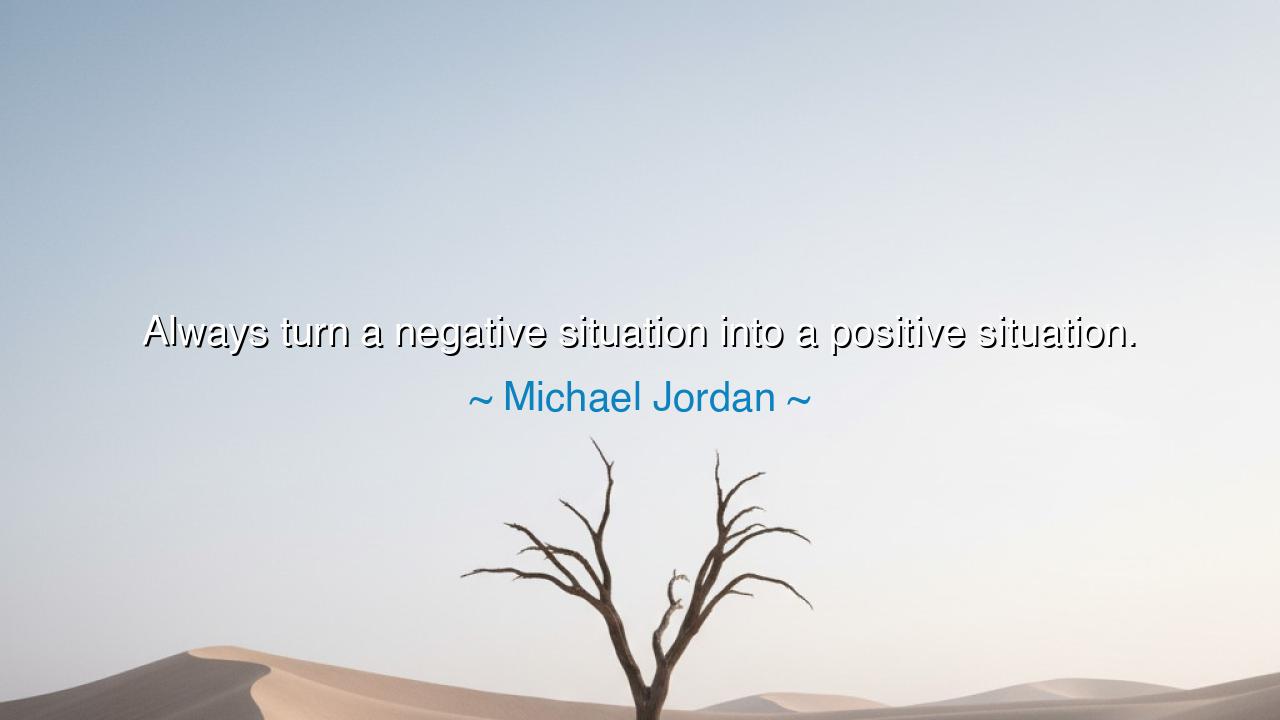
Always turn a negative situation into a positive situation.






Hear now the words of the champion, Michael Jordan, who declared: “Always turn a negative situation into a positive situation.” These words are not the light chatter of an idle man, but the tempered wisdom of one who wrestled with defeat, injury, and doubt, and yet rose to glory. They echo through time as a command to warriors of every age: when the storm rises against you, do not wither—transform it into the wind that carries your sails. For what is adversity but the hidden teacher, and what is despair but the raw clay from which triumph may be shaped?
The ancients taught that fire purifies gold. So too does hardship purify the soul. A negative situation is the trial by fire, the dark hour before dawn, the weight pressing upon the chest. But Jordan bids us not to curse the fire, nor collapse under the weight, but to embrace it, to forge within it the weapon of renewal. To turn it into the positive is not to deny suffering, but to wrest from it meaning, strength, and clarity of purpose. This transformation is the alchemy of the spirit, where pain becomes power, and defeat becomes destiny.
Consider the life of Nelson Mandela. Imprisoned for twenty-seven years, separated from his family, confined to stone walls meant to break the human spirit—his situation was one of deepest negativity. Yet Mandela emerged not filled with bitterness, but with vision, patience, and strength. He transformed captivity into preparation, sorrow into wisdom, and emerged as the leader who would unite a divided nation. What the world sought to destroy, he transmuted into the very force that would heal. In this way, Mandela stands beside Jordan’s teaching, a living witness to the law of transformation.
To follow this teaching requires both courage and creativity. A man who loses his livelihood may discover, through the ashes of despair, the seed of a new calling. A woman betrayed by friends may rise to forge deeper bonds with others, her heart strengthened by scars. Even the athlete, cut down by injury, may find within the silence of recovery a new hunger, a new perspective, and return fiercer than before. The command is not simply to endure but to create—to fashion from brokenness a new wholeness, brighter and stronger.
Yet we must remember: the mind is the battlefield. For many, a negative situation becomes a chain, dragging them into darkness. The key lies in perception. The wise do not ask, “Why has this misfortune come?” but rather, “What may I build from this stone?” The same stone may crush the spirit or form the foundation of a temple. Thus Jordan’s words demand a shift of vision—an awakening to see in every trial not the tomb of dreams, but the womb of opportunity.
The lesson, then, is eternal: do not flee the shadow, but use it to sharpen your light. When the world pushes you down, stand taller; when you stumble, let the fall teach you new ways to rise. The call is not merely to survive but to transform—to weave threads of grief into garments of strength, to shape setbacks into stepping stones.
Practical actions flow from this teaching. When adversity strikes, pause and breathe, asking, “What can I learn here?” Write the lesson down, let it take root. Seek out the strength hidden in the difficulty—patience, discipline, compassion, or resilience. Train your mind to reframe misfortune as fuel. Surround yourself with those who also believe in transformation, for the company of the hopeful strengthens the heart. And above all, act—do not let despair paralyze you, but move forward, even in small steps, until the path emerges.
Thus the words of Michael Jordan, like the wisdom of prophets and sages, become more than a saying; they are a way of life. Always turn a negative situation into a positive situation. To live by this creed is to live as one who cannot be conquered, who cannot be broken, for every arrow of fate that strikes you becomes a sword in your hand. And so, let this teaching be carried in your heart: no darkness can overcome the one who has learned to make light from it.






MPThao My Phung
This statement sparks curiosity about emotional intelligence and coping strategies. Could focusing on the positive in challenging situations improve mental health, resilience, and decision-making? I also wonder whether this approach is a skill that can be learned, or if it comes more naturally to some individuals. Finally, how might this mindset influence leadership, teamwork, and problem-solving in both personal and professional contexts?
L118.Huong Linh 10a15
I appreciate the focus on transforming adversity, yet it raises philosophical questions. Does every negative event hold a potential benefit, or is this more about personal perception than objective outcomes? I also ponder whether this advice assumes a level of privilege and resources that not everyone has. How can people facing systemic obstacles apply this principle meaningfully without oversimplifying their reality?
LVLe Vy
Reading this, I feel motivated but skeptical. How does one practically turn a negative situation into a positive? Does it mean looking for lessons, reframing our perspective, or taking proactive action? I also question whether this mindset might inadvertently minimize valid emotions like grief, anger, or disappointment. How can we balance optimism with honesty about the challenges we face in life?
DTYen nhi Du Thi
This quote makes me think about resilience and mindset. Is it truly possible to turn every negative situation into a positive one, or are there circumstances beyond our control that require acceptance rather than transformation? I also wonder how this philosophy applies to relationships, work, and personal growth. Can constantly striving to find the positive lead to emotional exhaustion if we ignore legitimate frustrations or setbacks?